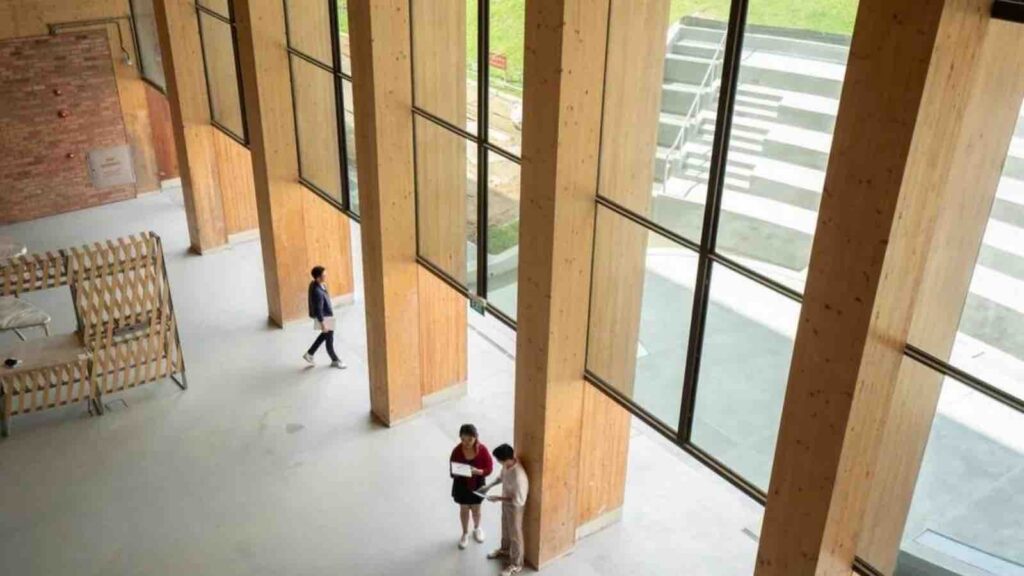A sustainable vision meets tropical reality. The reality of Singapore’s tropical climate has brought an unexpected challenge: mold growth on the Gaia building’s wooden surfaces.
When the Gaia building at Nanyang Technological University (NTU) opened in May 2023, it was celebrated as a milestone in sustainable architecture. As Asia’s largest wooden building, constructed almost entirely from mass timber, Gaia was designed to be a model of eco-friendly construction. However, the reality of Singapore’s tropical climate has brought an unexpected challenge: mold growth on the building’s wooden surfaces.
RELEVANT SUSTAINABLE GOALS



The Gaia Building: An Ambitious Eco-Friendly Project
Gaia, which houses NTU’s Nanyang Business School, is the university’s eighth zero-energy building. Constructed from sustainably harvested Austrian spruce, the building’s wooden structure was intended to act as a natural insulator, trapping less heat than traditional concrete buildings. The timber used in Gaia is also a significant carbon sink, storing more than 4,535 tonnes of carbon dioxide, according to the university. This made Gaia a symbol of Singapore’s commitment to reducing carbon emissions and promoting sustainable construction.
The Mold Problem: A Climate Mismatch
Despite its green credentials, Gaia’s timber structure has proven vulnerable to Singapore’s high humidity, where relative humidity levels often exceed 80%. The Austrian spruce used in the building, while environmentally friendly, has a lower resistance to mold compared to other wood species. This has led to visible mold growth on the walls and wooden pillars, particularly on the building’s upper floors.
Andrew Wong of the International Wood Culture Society explains that this issue is largely climate-related: “We’re in the tropics, and that requires special attention.” The mold problem at Gaia highlights the challenges that timber structures face in different climates, from the expansion and contraction caused by temperature fluctuations in desert climates to the risk of cracking and splitting in subzero environments.
The mold issues at Gaia are not unique to Singapore. Around the world, companies and institutions have embraced timber as a sustainable construction material, from Walmart Inc. to Microsoft Corp. However, moldy timber has led to health concerns, property damage, and legal disputes in cities as diverse as London and Melbourne. While timber construction is praised for its low carbon footprint—trees absorb carbon dioxide as they grow—the practical challenges of maintaining wooden buildings in various climates are becoming increasingly apparent.
Maintaining Gaia: A Balancing Act Between Sustainability and Practicality
NTU has developed a comprehensive maintenance plan to address the mold problem at Gaia. This includes reapplying sealant to the timber, adjusting air-conditioning settings, and encouraging staff to keep windows closed to reduce condensation. Other measures, such as treating surfaces with bleach and installing dehumidifiers, have been considered, though these solutions may compromise the building’s sustainability by increasing energy consumption.
The lead architect for Gaia, Loh Kee Soon of RSP Architects Planners & Engineers, has stated that the mold is unlikely to affect the building’s structural integrity. Nevertheless, the situation underscores the importance of tailoring sustainable solutions to local conditions. While Gaia’s design was innovative, its challenges serve as a reminder that sustainability must be adapted to the specific environmental realities of each location.
The mold issues at Gaia highlight the need for a more nuanced approach to sustainable construction, especially in tropical climates like Singapore’s. As the global push for greener buildings continues, it is crucial that architects and engineers account for local conditions to ensure that eco-friendly designs are not only environmentally beneficial but also practical and durable. Gaia’s experience serves as a case study in the complexities of sustainable building, offering valuable lessons for future projects in similar climates.
You may also be interested in :
Transforming Seoul’s Banjiha: A Blueprint For Resilient Housing In A Changing Climate


